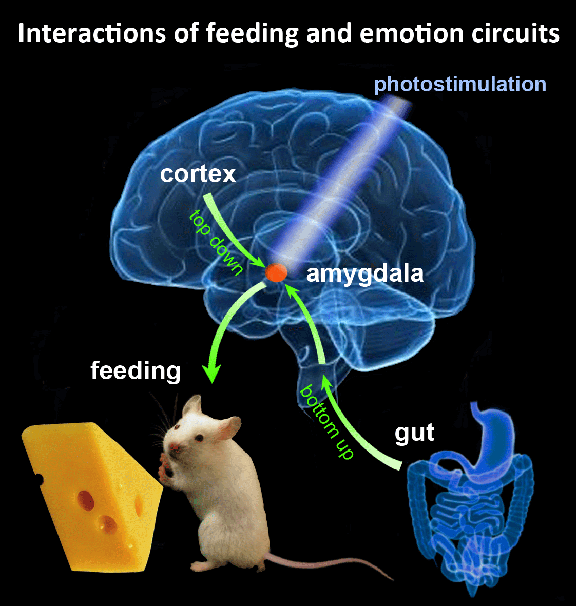
Rm 427 Gould-Simpson
Mailing Address:
GS 611, Department of Neuroscience, University of Arizona
1040 E. 4th St. PO Box 210077, Tucson, AZ 85721-0077
B.S. University of Science & Technology of China, 2001; Ph.D. University of Southern California, 2007; Postdoc, Caltech, 2008-2015.
Research
We are studying the neural circuits of animal behaviors, with a focus on understanding how the neural circuits regulate feeding and emotional behaviors such as fear, anxiety, and depression.
 1. Interactions of the feeding and emotion neural circuits. One fascinating and important phenomenon (or problem) in neuroscience is that many neuronal diseases are co-morbid. For example, most eating disorder patients also have emotional disorders such as depression and anxiety. However, relatively little is known about the neurobiology underlying eating disorders, even less is known about its relationship to emotional disorders. Recently, we have identified a specific population of neurons in central amygdala (CEA), called PKC-δ+ neurons, that play important roles in regulating both feeding and emotional behaviors including anxiety and conditioned fear (Nature Neuroscience 2014, 17:1240 and Nature 2010, 468:270). This work has opened the door to understanding interactions of the feeding and emotion circuits. One immediate important question is whether the same or rather different subset of CEA PKC-δ+ neurons mediate these different behaviors.
1. Interactions of the feeding and emotion neural circuits. One fascinating and important phenomenon (or problem) in neuroscience is that many neuronal diseases are co-morbid. For example, most eating disorder patients also have emotional disorders such as depression and anxiety. However, relatively little is known about the neurobiology underlying eating disorders, even less is known about its relationship to emotional disorders. Recently, we have identified a specific population of neurons in central amygdala (CEA), called PKC-δ+ neurons, that play important roles in regulating both feeding and emotional behaviors including anxiety and conditioned fear (Nature Neuroscience 2014, 17:1240 and Nature 2010, 468:270). This work has opened the door to understanding interactions of the feeding and emotion circuits. One immediate important question is whether the same or rather different subset of CEA PKC-δ+ neurons mediate these different behaviors.
2. Central neural circuits of gut-brain communication. Satiety signals such as CCK are released in the gastrointestinal tract (GI tract) during a meal. They activate the vagus nerves to reach the central brain nucleus tractus solitarius (NTS), and then to the parabrachial nucleus (PBN). PBN sends information further to CEA and other nucleus to stop feeding. Other anorexigenic signals including LiCl and bitter tastant, are also using similar pathways to reach the central brain to mediate various behavioral responses. Interestingly, CEA neurons represent the first inhibitory relay in this pathway. Therefore, conventional mapping methods such as c-Fos staining cannot go further downstream of this pathway. The genetic identification of CEA PKC-δ+ neurons provided us a unique tool to investigate the gut-brain communication in a specific way and determine the downstream brain regions after CEA.
3. Feeding and emotion circuits in energy balance, metabolism, and obesity. More and more evidences suggest that the neural circuits regulate emotion and acute feeding behaviors also contribute to the long term homeostasis of energy balance, metabolism, and body weight. Do CEA neural circuits also regulate obesity, a more and more serious global health problem in modern society? The neurons in the hypothalamic nuclei (Hyp), including lateral hypothalamus, arcuate nucleus, and paraventricular hypothalamic nucleus, have been well demonstrated to be involved in acute feeding regulation and long term energy homeostasis. What is the relationship of the CEA feeding circuits to the circuits in the hypothalamic nuclei?
Selected Publications (click here for the complete list)
- H Cai, W Haubensak, TE Anthony, DJ Anderson (2014) Central amygdala PKC-δ+ neurons mediate the influence of multiple anorexigenic signals. Nature neuroscience. 17 (9), 1240. ( The New York Times: A mouse switch turns off appetite )
- W Haubensak, PS Kunwar*, H Cai*, S Ciocchi*, NR Wall, R Ponnusamy, J Biag, HW Dong, K Deisseroth, EM Callaway, MS Fanselow, A Lüthi, DJ Anderson. (2010) Genetic dissection of an amygdala microcircuit that gates conditioned fear. Nature 468 (7321), 270. *equal contribution
- H Cai, K Reim, F Varoqueaux, S Tapechum, K Hill, JB Sørensen, N Brose, RH Chow (2008) Complexin II plays a positive role in Ca2+-triggered exocytosis by facilitating vesicle priming. Proceedings of the National Academy of Sciences 105 (49), 19538-19543
Teaching
NROS 418 (Spring, with Dr. Lynne Oland): Fundamental Principles in Systems Neuroscience
NROS 307H (Fall)
Lab Members
Yong Wang, Ph.D. Postdoctoral fellow
Matthew Schmit, PhD Student, GIDP in Neuroscience
JungMin Kim, Research Technician
Ross Mansouri-Rad, Research Technician
Anna Fang, Research Specialist
Tiffany Cho, Undergraduate Student
Makenna Anderson, University High School Student
Graduate program affiliation
